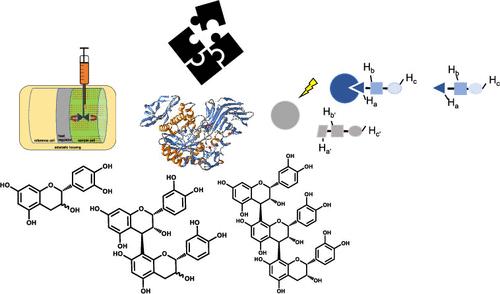应用等温滴定量热法和饱和转移差-核磁共振研究黄烷-3-醇与α-淀粉酶的相互作用模式,了解其对淀粉水解的影响
IF 6.2
1区 农林科学
Q1 AGRICULTURE, MULTIDISCIPLINARY
引用次数: 0
摘要
至于黄烷-3-醇,据推测对预防糖尿病的发生有显著效果。这主要归因于对肠道α-淀粉酶的抑制作用,尤其是对高分子量原花青素的抑制作用。为了更深入地了解相互作用的模式及其对α-淀粉酶的抑制作用,研究了单体(+)-儿茶素(CAT)和(-)-表儿茶素(EC)、二聚体原花青素(PC)B1和PC B2以及三聚体PC C1之间的相互作用及其对猪胰腺α-淀粉酶的抑制作用。通过等温滴定量热法(ITC)确定了它们之间的弱相互作用,单体和二聚体之间没有明显的差异,甚至与 PC C1 之间也没有观察到相互作用。饱和转移差(STD)-核磁共振实验的数据支持了这些可逆相互作用的结果。详细的核磁共振信号分配显示,旋转体的形成与溶剂有关,这或许可以解释两种非对映异构体之间相互作用强度的差异。在采用新颖的 ITC 连续方法监测天然底物淀粉的水解时,随着聚合度的增加,相互作用的抑制强度也在增加,而这一结果与此形成了鲜明对比。综合相互作用和抑制研究的数据,我们认为蛋白质在黄烷-3-醇低聚物的存在下发生聚合,从而产生抑制作用。这种不可逆的相互作用无法通过 ITC 和 STD-NMR 检测到,也无法通过 CD 光谱观察到。本文章由计算机程序翻译,如有差异,请以英文原文为准。

Applying Isothermal Titration Calorimetry and Saturation Transfer Difference-NMR to Study the Mode of Interaction of Flavan-3-ols with α-Amylase to Understand Their Impact on Starch Hydrolysis
For flavan-3-ols, significant effects to prevent the development of diabetes mellitus are postulated. Inter alia, this is attributed to inhibitory effects on the intestinal α-amylase, in particular for high-molecular-weight procyanidins. In order to gain a deeper insight into the mode of interaction and the resulting α-amylase inhibition, the interaction between the monomers (+)-catechin (CAT) and (−)-epicatechin (EC), the dimers procyanidin (PC) B1 and PC B2, and the trimer PC C1 and their inhibition of porcine pancreatic α-amylase were investigated. Weak interactions were determined by isothermal titration calorimetry (ITC), with no clear difference between monomers and dimers and even no observable interaction with PC C1. Data from saturation transfer difference (STD)-NMR experiments supported these results with respect to reversible interactions. The detailed NMR signal assignments revealed that the formation of rotamers is solvent-dependent, which might explain the differences in the interaction strength between both diastereomers. The results for interaction were in contrast to the accumulating inhibitory strength with an increasing degree of polymerization when monitoring hydrolysis of the natural substrate starch in a novel continuous approach by ITC. By combining the data from the interaction and inhibition studies, we propose that protein aggregation occurs in the presence of flavan-3-ol oligomers, which are responsible for the inhibitory effects. This rather irreversible interaction is not susceptible to detection by ITC and STD-NMR and was also not observable by CD spectroscopy.
求助全文
通过发布文献求助,成功后即可免费获取论文全文。
去求助
来源期刊
CiteScore
9.90
自引率
8.20%
发文量
1375
审稿时长
2.3 months
期刊介绍:
The Journal of Agricultural and Food Chemistry publishes high-quality, cutting edge original research representing complete studies and research advances dealing with the chemistry and biochemistry of agriculture and food. The Journal also encourages papers with chemistry and/or biochemistry as a major component combined with biological/sensory/nutritional/toxicological evaluation related to agriculture and/or food.

 求助内容:
求助内容: 应助结果提醒方式:
应助结果提醒方式:


